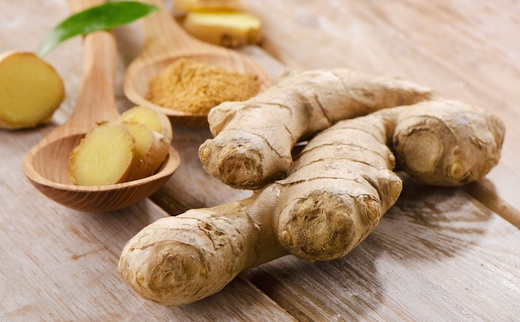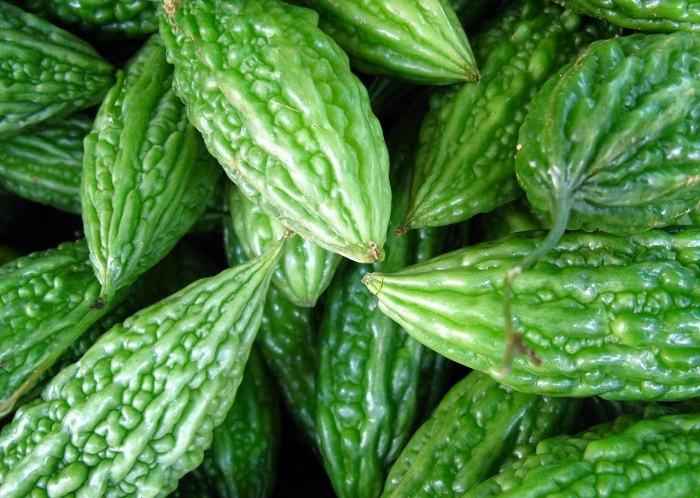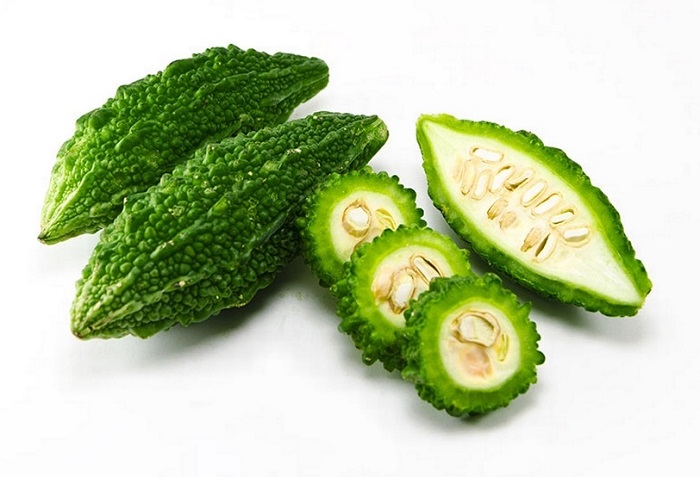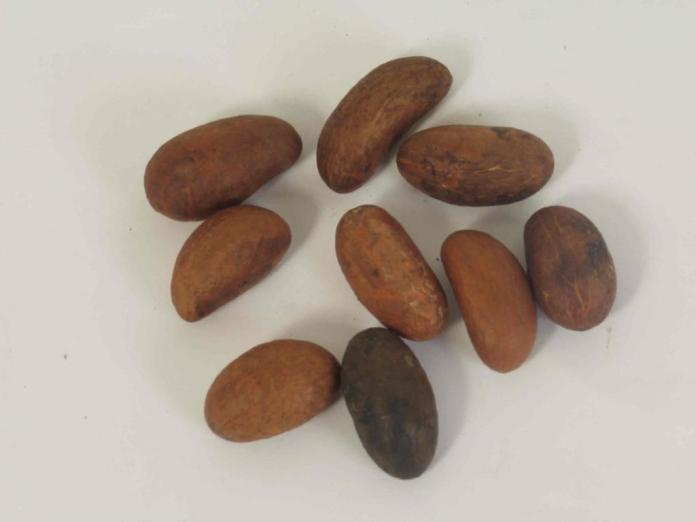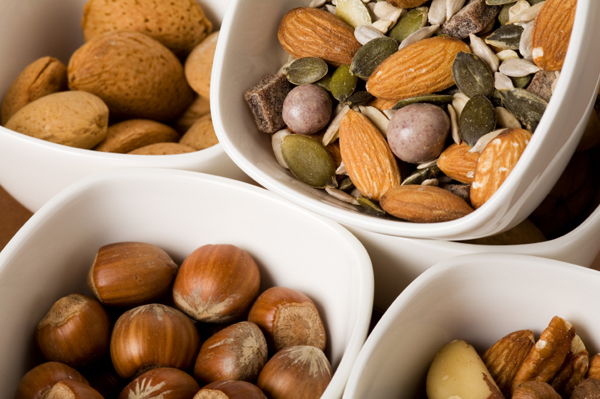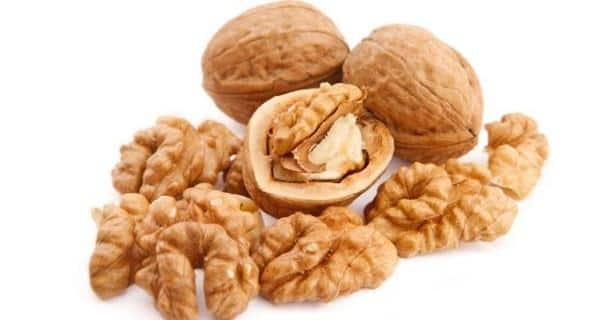Historically, ginger has a long tradition of being very effective in
alleviating symptoms of gastrointestinal distress. In herbal medicine,
ginger is regarded as an excellent carminative (a substance which promotes the elimination of intestinal gas) and intestinal spasmolytic
(a substance which relaxes and soothes the intestinal tract). Modern
scientific research has revealed that ginger possesses numerous
therapeutic properties including antioxidant effects, an ability to
inhibit the formation of inflammatory compounds, and direct
anti-inflammatory effects.
In this study, researchers from the University of Minnesota's Hormel Institute fed mice specially bred to lack an immune system a half milligram of (6)-gingerol three times a week before and after injecting human colorectal cancer cells into their flanks. Control mice received no (6)-gingerol.
Tumors first appeared 15 days after the mice were injected, but only 4 tumors were found in the group of -gingerol-treated mice compared to 13 in the control mice, plus the tumors in the -gingerol group were smaller on average. Even by day 38, one mouse in the (6)-gingerol group still had no measurable tumors. By day 49, all the control mice had been euthanized since their tumors had grown to one cubic centimeter (0.06 cubic inch), while tumors in 12 of the (6)-gingerol treated mice still averaged 0.5 cubic centimeter—half the maximum tumor size allowed before euthanization.
Research associate professor Ann Bode noted, "These results strongly suggest that ginger compounds may be effective chemopreventive and/or chemotherapeutic agents for colorectal carcinomas."
In this first round of experiments, mice were fed ginger before and after tumor cells were injected. In the next round, researchers will feed the mice ginger only after their tumors have grown to a certain size. This will enable them to look at the question of whether a patient could eat ginger to slow the metastasis of a nonoperable tumor. Are they optimistic? The actions of the University of Minnesota strongly suggest they are. The University has already applied for a patent on the use of (6)-gingerol as an anti-cancer agent and has licensed the technology to Pediatric Pharmaceuticals (Iselin, N.J.).
Ginger extracts have been shown to have both antioxidant, anti-inflammatory and anti-tumor effects on cells. To investigate the latter, Dr Liu examined the effect of a whole ginger extract containing 5% gingerol on a number of different ovarian cancer cell lines.
Exposure to the ginger extract caused cell death in all the ovarian cancer lines studied.
A pro-inflammatory state is thought to be an important contributing factor in the development of ovarian cancer. In the presence of ginger, a number of key indicators of inflammation (vascular endothelial growth factor, interleukin-8 and prostaglandin E2) were also decreased in the ovarian cancer cells.
Conventional chemotherapeutic agents also suppress these inflammatory markers, but may cause cancer cells to become resistant to the action of the drugs. Liu and her colleagues believe that ginger may be of special benefit for ovarian cancer patients because cancer cells exposed to ginger do not become resistant to its cancer-destroying effects. In the case of ovarian cancer, an ounce of prevention—in the delicious form of liberal use of ginger—is an especially good idea. Ovarian cancer is often deadly since symptoms typically do not appear until late in the disease process, so by the time ovarian cancer is diagnosed, it has spread beyond the ovaries. More than 50% of women who develop ovarian cancer are diagnosed in the advanced stages of the disease.
Ginger is so concentrated with active substances, you don't have to use very much to receive its beneficial effects. For nausea, ginger tea made by steeping one or two 1/2-inch slices (one 1/2-inch slice equals 2/3 of an ounce) of fresh ginger in a cup of hot water will likely be all you need to settle your stomach. For arthritis, some people have found relief consuming as little as a 1/4-inch slice of fresh ginger cooked in food, although in the studies noted above, patients who consumed more ginger reported quicker and better relief.
The flesh of the ginger rhizome can be yellow, white or red in color, depending upon the variety. It is covered with a brownish skin that may either be thick or thin, depending upon whether the plant was harvested when it was mature or young. The ginger rhizome has a firm, yet striated texture and a taste that is aromatic, pungent and hot.
Today, the top commercial producers of ginger include Jamaica, India, Fiji, Indonesia and Australia.
Even through dried herbs and spices like ginger powder are widely available in supermarkets, you may want to explore the local spice stores in your area. Oftentimes, these stores feature an expansive selection of dried herbs and spices that are of superior quality and freshness than those offered in regular markets. Just like with other dried spices, when purchasing dried ginger powder try to select organically grown ginger since this will give you more assurance that it has not been irradiated.
Ginger is also available in several other forms including crystallized, candied and pickled ginger.
Fresh ginger can be stored in the refrigerator for up to three weeks if it is left unpeeled. Stored unpeeled in the freezer, it will keep for up to six months.
Dried ginger powder should be kept in a tightly sealed glass container in a cool, dark and dry place. Alternatively, you can store it in the refrigerator where it will enjoy an extended shelf life of about one year.
Gastrointestinal Relief
A clue to ginger's success in eliminating gastrointestinal distress is offered by recent double-blind studies, which have demonstrated that ginger is very effective in preventing the symptoms of motion sickness, especially seasickness. In fact, in one study, ginger was shown to be far superior to Dramamine, a commonly used over-the-counter and prescription drug for motion sickness. Ginger reduces all symptoms associated with motion sickness including dizziness, nausea, vomiting, and cold sweating.Safe and Effective Relief of Nausea and Vomiting During Pregnancy
Ginger's anti-vomiting action has been shown to be very useful in reducing the nausea and vomiting of pregnancy, even the most severe form, hyperemesis gravidum, a condition which usually requires hospitalization. In a double-blind trial, ginger root brought about a significant reduction in both the severity of nausea and number of attacks of vomiting in 19 of 27 women in early pregnancy (less than 20 weeks). Unlike antivomiting drugs, which can cause severe birth defects, ginger is extremely safe, and only a small dose is required.
A review of six double-blind, randomized controlled trials with a total
of 675 participants, published in the April 2005 issue of the journal, Obstetrics and Gynecology,has
confirmed that ginger is effective in relieving the severity of nausea
and vomiting during pregnancy. The review also confirmed the absence of
significant side effects or adverse effects on pregnancy outcomes.
Anti-Inflammatory Effects
Ginger contains very potent anti-inflammatory compounds called gingerols. These substances are believed to explain why so many people with osteoarthritis or rheumatoid arthritis experience reductions in their pain levels and improvements in their mobility when they consume ginger regularly. In two clinical studies involving patients who responded to conventional drugs and those who didn't, physicians found that 75% of arthritis patients and 100% of patients with muscular discomfort experienced relief of pain and/or swelling.
Arthritis-related problems with your aging knees? Regularly spicing
up your meals with fresh ginger may help, suggests a study published in a
recent issue of Osteoarthritis Cartilage. In this twelve month
study, 29 patients with painful arthritis in the knee (6 men and 23
women ranging in age from 42-85 years) participated in a
placebo-controlled, double-blind, crossover study. Patients switched
from placebo to ginger or visa versa after 3 months. After six months,
the double-blind code was broken and twenty of the patients who wished
to continue were followed for an additional six months.
By the end of the first six month period, those given ginger were experiencing significantly less pain on movement and handicap than those given placebo. Pain on movement decreased from a score of 76.14 at baseline to 41.00, while handicap decreased from 73.47 to 46.08. In contrast, those who were switched from ginger to placebo experienced an increase in pain of movement (up to 82.10) and handicap (up to 80.80) from baseline. In the final phase of the study when all patients were getting ginger, pain remained low in those already taking ginger in phase 2, and decreased again in the group that had been on placebo.
Not only did participants' subjective experiences of pain lessen, but swelling in their knees, an objective measurement of lessened inflammation, dropped significantly in those treated with ginger. The mean target knee circumference in those taking ginger dropped from 43.25cm when the study began to 39.36cm by the 12th week. When this group was switched to placebo in the second phase of the study, their knee circumferences increased, while those who had been on placebo but were now switched to ginger experienced a decrease in knee circumference. In the final phase, when both groups were given ginger, mean knee circumference continued to drop, reaching lows of 38.78 and 36.38 in the two groups.
How does ginger work its anti-inflammatory magic? Two other recent studies provide possible reasons.
A study published in the November 2003 issue of Life Sciences suggests that at least one reason for ginger's beneficial effects is the free radical protection afforded by one of its active phenolic constituents, 6-gingerol. In this in vitro (test tube) study, 6-gingerol was shown to significantly inhibit the production of nitric oxide, a highly reactive nitrogen molecule that quickly forms a very damaging free radical called peroxynitrite. Another study appearing in the November 2003 issue of Radiation Research found that in mice, five days treatment with ginger (10 mg per kilogram of body weight) prior to exposure to radiation not only prevented an increase in free radical damage to lipids (fats found in numerous bodily components from cell membranes to cholesterol), but also greatly lessened depletion of the animals' stores of glutathione, one of the body's most important internally produced antioxidants.
By the end of the first six month period, those given ginger were experiencing significantly less pain on movement and handicap than those given placebo. Pain on movement decreased from a score of 76.14 at baseline to 41.00, while handicap decreased from 73.47 to 46.08. In contrast, those who were switched from ginger to placebo experienced an increase in pain of movement (up to 82.10) and handicap (up to 80.80) from baseline. In the final phase of the study when all patients were getting ginger, pain remained low in those already taking ginger in phase 2, and decreased again in the group that had been on placebo.
Not only did participants' subjective experiences of pain lessen, but swelling in their knees, an objective measurement of lessened inflammation, dropped significantly in those treated with ginger. The mean target knee circumference in those taking ginger dropped from 43.25cm when the study began to 39.36cm by the 12th week. When this group was switched to placebo in the second phase of the study, their knee circumferences increased, while those who had been on placebo but were now switched to ginger experienced a decrease in knee circumference. In the final phase, when both groups were given ginger, mean knee circumference continued to drop, reaching lows of 38.78 and 36.38 in the two groups.
How does ginger work its anti-inflammatory magic? Two other recent studies provide possible reasons.
A study published in the November 2003 issue of Life Sciences suggests that at least one reason for ginger's beneficial effects is the free radical protection afforded by one of its active phenolic constituents, 6-gingerol. In this in vitro (test tube) study, 6-gingerol was shown to significantly inhibit the production of nitric oxide, a highly reactive nitrogen molecule that quickly forms a very damaging free radical called peroxynitrite. Another study appearing in the November 2003 issue of Radiation Research found that in mice, five days treatment with ginger (10 mg per kilogram of body weight) prior to exposure to radiation not only prevented an increase in free radical damage to lipids (fats found in numerous bodily components from cell membranes to cholesterol), but also greatly lessened depletion of the animals' stores of glutathione, one of the body's most important internally produced antioxidants.
A study published in the February 2005 issue of the Journal of Alternative and Complementary Medicine
sheds further light on the mechanisms of action that underlie ginger's
anti-inflammatory effectiveness. In this research, ginger was shown to
suppress the pro-inflammatory compounds (cytokines and chemokines)
produced by synoviocytes (cells comprising the synovial lining of the
joints), chrondrocytes (cells comprising joint cartilage) and leukocytes
(immune cells).
Protection against Colorectal Cancer
Gingerols, the main active components in ginger and the ones responsible for its distinctive flavor, may also inhibit the growth of human colorectal cancer cells, suggests research presented at the Frontiers in Cancer Prevention Research, a major meeting of cancer experts that took place in Phoenix, AZ, October 26-30, 2003.In this study, researchers from the University of Minnesota's Hormel Institute fed mice specially bred to lack an immune system a half milligram of (6)-gingerol three times a week before and after injecting human colorectal cancer cells into their flanks. Control mice received no (6)-gingerol.
Tumors first appeared 15 days after the mice were injected, but only 4 tumors were found in the group of -gingerol-treated mice compared to 13 in the control mice, plus the tumors in the -gingerol group were smaller on average. Even by day 38, one mouse in the (6)-gingerol group still had no measurable tumors. By day 49, all the control mice had been euthanized since their tumors had grown to one cubic centimeter (0.06 cubic inch), while tumors in 12 of the (6)-gingerol treated mice still averaged 0.5 cubic centimeter—half the maximum tumor size allowed before euthanization.
Research associate professor Ann Bode noted, "These results strongly suggest that ginger compounds may be effective chemopreventive and/or chemotherapeutic agents for colorectal carcinomas."
In this first round of experiments, mice were fed ginger before and after tumor cells were injected. In the next round, researchers will feed the mice ginger only after their tumors have grown to a certain size. This will enable them to look at the question of whether a patient could eat ginger to slow the metastasis of a nonoperable tumor. Are they optimistic? The actions of the University of Minnesota strongly suggest they are. The University has already applied for a patent on the use of (6)-gingerol as an anti-cancer agent and has licensed the technology to Pediatric Pharmaceuticals (Iselin, N.J.).
Ginger Induces Cell Death in Ovarian Cancer Cells
Lab experiments presented at the 97th Annual Meeting of the American Association for Cancer, by Dr Rebecca Lui and her colleagues from the University of Michigan, showed that gingerols, the active phytonutrients in ginger, kill ovarian cancer cells by inducing apoptosis (programmed cell death) and autophagocytosis (self-digestion).Ginger extracts have been shown to have both antioxidant, anti-inflammatory and anti-tumor effects on cells. To investigate the latter, Dr Liu examined the effect of a whole ginger extract containing 5% gingerol on a number of different ovarian cancer cell lines.
Exposure to the ginger extract caused cell death in all the ovarian cancer lines studied.
A pro-inflammatory state is thought to be an important contributing factor in the development of ovarian cancer. In the presence of ginger, a number of key indicators of inflammation (vascular endothelial growth factor, interleukin-8 and prostaglandin E2) were also decreased in the ovarian cancer cells.
Conventional chemotherapeutic agents also suppress these inflammatory markers, but may cause cancer cells to become resistant to the action of the drugs. Liu and her colleagues believe that ginger may be of special benefit for ovarian cancer patients because cancer cells exposed to ginger do not become resistant to its cancer-destroying effects. In the case of ovarian cancer, an ounce of prevention—in the delicious form of liberal use of ginger—is an especially good idea. Ovarian cancer is often deadly since symptoms typically do not appear until late in the disease process, so by the time ovarian cancer is diagnosed, it has spread beyond the ovaries. More than 50% of women who develop ovarian cancer are diagnosed in the advanced stages of the disease.
Immune Boosting Action
Ginger can not only be warming on a cold day, but can help promote healthy sweating, which is often helpful during colds and flus. A good sweat may do a lot more than simply assist detoxification. German researchers have recently found that sweat contains a potent germ-fighting agent that may help fight off infections. Investigators have isolated the gene responsible for the compound and the protein it produces, which they have named dermicidin. Dermicidin is manufactured in the body's sweat glands, secreted into the sweat, and transported to the skin's surface where it provides protection against invading microorganisms, including bacteria such as E. coli and Staphylococcus aureus (a common cause of skin infections), and fungi, including Candida albicans.Ginger is so concentrated with active substances, you don't have to use very much to receive its beneficial effects. For nausea, ginger tea made by steeping one or two 1/2-inch slices (one 1/2-inch slice equals 2/3 of an ounce) of fresh ginger in a cup of hot water will likely be all you need to settle your stomach. For arthritis, some people have found relief consuming as little as a 1/4-inch slice of fresh ginger cooked in food, although in the studies noted above, patients who consumed more ginger reported quicker and better relief.
Description
The spice ginger is the underground rhizome of the ginger plant, known botanically as Zingiber officinale. The plant's botanical name is thought to be derived from its Sanskrit name singabera which means "horn shaped," a physical characteristic that ginger reflects.The flesh of the ginger rhizome can be yellow, white or red in color, depending upon the variety. It is covered with a brownish skin that may either be thick or thin, depending upon whether the plant was harvested when it was mature or young. The ginger rhizome has a firm, yet striated texture and a taste that is aromatic, pungent and hot.
History
Native to southeastern Asia, a region whose cuisines still feature this wonderfully spicy herb, ginger has been renowned for millennia in many areas throughout the world. Ginger is mentioned in ancient Chinese, Indian and Middle Eastern writings, and has long been prized for its aromatic, culinary and medicinal properties. After the ancient Romans imported ginger from China almost two thousand years ago, its popularity in Europe remained centered in the Mediterranean region until the Middle Ages when its use spread throughout other countries. Although it was a very expensive spice, owing to the fact that it had to be imported from Asia, it was still in great demand. In an attempt to make it more available, Spanish explorers introduced ginger to the West Indies, Mexico and South America, and in the 16th century, these areas began exporting the precious herb back to Europe.Today, the top commercial producers of ginger include Jamaica, India, Fiji, Indonesia and Australia.
How to Select and Store
Whenever possible, choose fresh ginger over the dried form of the spice since it is not only superior in flavor but contains higher levels of gingerol as well as ginger's active protease (it's anti-inflammatory compound). Fresh ginger root is sold in the produce section of markets. When purchasing fresh ginger root, make sure it is firm, smooth and free of mold. Ginger is generally available in two forms, either young or mature. Mature ginger, the more widely available type, has a tough skin that requires peeling while young ginger, usually only available in Asian markets, does not need to be peeled.Even through dried herbs and spices like ginger powder are widely available in supermarkets, you may want to explore the local spice stores in your area. Oftentimes, these stores feature an expansive selection of dried herbs and spices that are of superior quality and freshness than those offered in regular markets. Just like with other dried spices, when purchasing dried ginger powder try to select organically grown ginger since this will give you more assurance that it has not been irradiated.
Ginger is also available in several other forms including crystallized, candied and pickled ginger.
Fresh ginger can be stored in the refrigerator for up to three weeks if it is left unpeeled. Stored unpeeled in the freezer, it will keep for up to six months.
Dried ginger powder should be kept in a tightly sealed glass container in a cool, dark and dry place. Alternatively, you can store it in the refrigerator where it will enjoy an extended shelf life of about one year.
Tips for Preparing and Cooking
Tips for Preparing Ginger
To remove the skin from fresh mature ginger, peel with a paring knife. The ginger can then be sliced, minced or julienned. The taste that ginger imparts to a dish depends upon when it is added during the cooking process. Added at the beginning, it will lend a subtler flavor while added near the end, it will deliver a more pungent taste.How to Enjoy
A Few Quick Serving Ideas
- Turn up the heat while cooling off by making ginger lemonade. Simply combine freshly grated ginger, lemon juice, cane juice or honey and water.
- Add extra inspiration to your rice side dishes by sprinkling grated ginger, sesame seeds and nori strips on top.
- Combine ginger, soy sauce, olive oil and garlic to make a wonderful salad dressing.
- Add ginger and orange juice to puréed sweet potatoes.
- Add grated ginger to your favorite stuffing for baked apples.
- Spice up your healthy sautéed vegetables by adding freshly minced ginger.
Individual Concerns
Ginger is not a commonly allergenic food and is not known to contain measurable amounts of oxalates or purines.Nutritional Profile
For an in-depth nutritional profile click here: Ginger.In-Depth Nutritional Profile
In addition to the nutrients highlighted in our ratings chart, an in-depth nutritional profile for Ginger is also available. This profile includes information on a full array of nutrients, including carbohydrates, sugar, soluble and insoluble fiber, sodium, vitamins, minerals, fatty acids, amino acids and more.Introduction to Food Rating System Chart
In order to better help you identify foods that feature a high concentration of nutrients for the calories they contain, we created a Food Rating System. This system allows us to highlight the foods that are especially rich in particular nutrients. The following chart shows the nutrients for which this food is either an excellent, very good, or good source (below the chart you will find a table that explains these qualifications). If a nutrient is not listed in the chart, it does not necessarily mean that the food doesn't contain it. It simply means that the nutrient is not provided in a sufficient amount or concentration to meet our rating criteria. (To view this food's in-depth nutritional profile that includes values for dozens of nutrients - not just the ones rated as excellent, very good, or good - please use the link below the chart.) To read this chart accurately, you'll need to glance up in the top left corner where you will find the name of the food and the serving size we used to calculate the food's nutrient composition. This serving size will tell you how much of the food you need to eat to obtain the amount of nutrients found in the chart. Now, returning to the chart itself, you can look next to the nutrient name in order to find the nutrient amount it offers, the percent Daily Value (DV%) that this amount represents, the nutrient density that we calculated for this food and nutrient, and the rating we established in our rating system. For most of our nutrient ratings, we adopted the government standards for food labeling that are found in the U.S. Food and Drug Administration's "Reference Values for Nutrition Labeling." Read more background information and details of our rating system.
Ginger, slices, fresh
1.00 TBS 6.00 grams | ||||
| Nutrient | Amount | DRI/DV (%) | Nutrient Density | World's Healthiest Foods Rating |
|---|---|---|---|---|
| World's Healthiest Foods Rating | Rule |
|---|---|
| excellent |
DRI/DV>=75% OR Density>=7.6 AND DRI/DV>=10% |
| very good |
DRI/DV>=50% OR Density>=3.4 AND DRI/DV>=5% |
| good |
DRI/DV>=25% OR Density>=1.5 AND DRI/DV>=2.5% |
